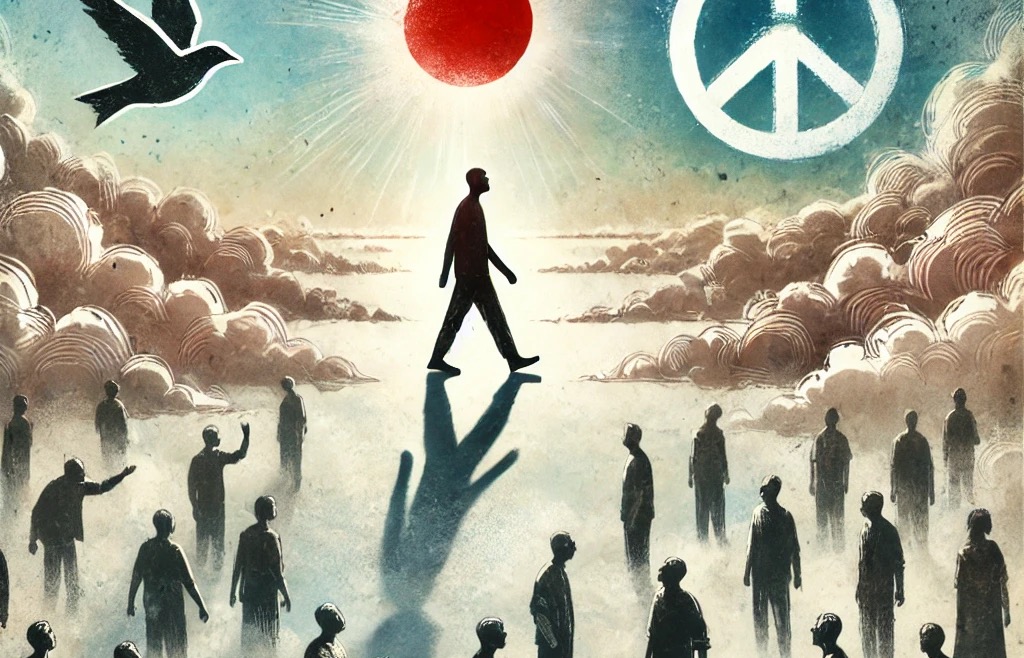You can silence a crowd with “Let me tell you a story.”
45,000 year old cave paintings are stories.
The hero’s journey is a story arc in tales from The Iliad to most Hollywood movies. The “seven basic plots” are said to comprise all story structures. Tolstoy said there are only two plots: ‘a hero goes on a journey’ and ‘a stranger comes to town’.
But if you look at what story is, it’s even simpler.
A person’s self-actualization = the triumph of good over evil. That’s every story ever told.
Think of any story and see if it isn’t — at its core — about destiny and good vs evil.
Interesting that this formula is baked into our consciousness.
Greed = fear of death
Fear and greed typify our villains.
Sometimes the villain is the hero’s own internal fear, holding him or her back from self-actualization. Think of Tyler Durden in Fight Club.
When the antagonist is external, they deny others the freedom to self-actualize, typically as a greedy villain seeking power. Think of Nurse Ratched in One Flew Over the Cuckoo’s Nest. McMurphy pushes the other patients to realize their true selves and reject her tyranny.
We could go on and on.
Throughout time, people have gathered resources to stave off death and keep our species going. Yet, once you have all you need, that instinct keeps going. If you take it to the extremes, it becomes a quest for immortality.
The villains’ greed comes from their own fear
The logic goes… With wealth and power, I can protect myself and my kin. With success, I might create a legacy that lasts generations. With ultimate success, I might immortalize myself in history.
This is at least one big piece of the psychology behind greed, the fear of dying and being forgotten.
Love = embrace of death
Love is an unhindered embrace of life, and you can’t completely embrace life without accepting death. To accept death, in turn, is to relinquish fear and greed, to put our limited life toward our true purpose.
In stories, true heroes will embrace death in order to fulfill their purpose. Look at the ends of Game of Thrones, The Hunger Games, The Matrix, The Lord of the Rings, Harry Potter, or the Bible.
The hero might be saved for the sake of a happy ending, but nonetheless, they selflessly trade their lives for fulfillment of their purpose.
In the real world, think of figures like Martin Luther King Jr., who spoke openly about the fact that he might be killed. Think of the word we used to describe healthcare workers in the pandemic. Heroes.
We could go on.
The quest for power (i.e., immortality) is evil. The placement of self-actualization over life itself (i.e., embrace of death) is good.
It’s selfless self-realization.
What does this mean for us as human beings?
Hold onto your seats. We’re gonna get a little spiritual.
Where does our love for stories come from? It seems to be deeply seated in our beings. Why? Why do stories include a built in tug-o-war between fear and greed vs love and selflessness?
And the ultimate metaphysical question. What is consciousness?
Traditional science refuses to go beyond a description of electrical activity in the brain and body. But some more modern scientists, researchers, and thinkers are beginning to explore the fundamental nature of consciousness.
They’re looking for the why. Why do a bunch of O, N, C, and H atoms come together to create life and consciousness?
Within traditional physics, they simply wouldn’t do that. The atoms would bounce around, fuse and fizz, bond and break, but they would NOT create lifeforms that devise their own thoughts, feelings, and movements. Not even if they were hit by a lightning bolt on a Goldilocks planet.
There has to be something else beyond physics. There simply has to be, or life wouldn’t be possible.
To believe consciousness is separate from other laws of nature is a bit like believing the Earth is at the center of the universe. Institutional science simply doesn’t understand it yet.
So, getting back to story.
Perhaps self-actualization as the triumph of good vs evil doesn’t begin with us. Maybe it begins from a universal consciousness—that “something more than physics”—which underlies the creation of life.
Back down to Earth
Selfless generosity, love, and creativity surround us. They’re strong in our communities, yet, it seems the prevailing paradigm (not the only paradigm) of our modern culture is one that stokes greed and fear.
Perhaps this is starting to change. What can each of us do to be a part of that change?
The individual challenge is inner transformation — be who you truly are, full of love for yourself and others, and an embodiment of peace and harmony. Start with meditation, prayer, writing, reading, daily exercise, music, travel, or whatever works for you, then begin to integrate your true self into your life.
The collective challenge is to create the mechanisms in our society — through capitalism, government, or other types of organization — to reward compassion, love, and creativity. The goal is to transform the paradigm.
If you choose to accept only the individual challenge, that’s already enough. If you choose to also take part in confronting the collective challenge, you can start or join a movement to help put these compassionate, loving mechanisms in place.
This story was originally posted on Medium, Dec. 11 2023.
References
Booker, Christopher. The Seven Basic Plots: Why We Tell Stories. Bloomsbury Continuum, 2004. https://www.academia.edu/40444461/THE_SEVEN_BASIC_PLOTS_Why_we_tell_stories
The Telepathy Tapes. Accessed January, 2025. https://thetelepathytapes.com/.



